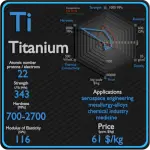This article contains comparison of key thermal and atomic properties of aluminium and silicon, two comparable chemical elements from the periodic table. It also contains basic descriptions and applications of both elements. Aluminium vs Silicon.
![]()
Aluminium and Silicon – About Elements

![]()
Source: www.luciteria.com
Aluminium and Silicon – Applications
Aluminium
Aluminium and its alloys are used widely in aerospace, automotive, architectural, lithographic, packaging, electrical and electronic applications. It is the prime material of construction for the aircraft industry throughout most of its history. About 70% of commercial civil aircraft airframes are made from aluminium alloys, and without aluminium civil aviation would not be economically viable. Automotive industry now includes aluminium as engine castings, wheels, radiators and increasingly as body parts. 6111 aluminium and 2008 aluminium alloy are extensively used for external automotive body panels. Cylinder blocks and crankcases are often cast made of aluminium alloys.
Silicon
Most silicon is used industrially without being purified, and indeed, often with comparatively little processing from its natural form. Silicon is a vital ingredient in aluminum, steel, and iron alloys. It is added as a fluxing agent for copper alloys. In the form of clay and sand, it is used to manufacture bricks and concrete; it is a valuable refractory material for high-temperature work, for example, molding sands for castings in foundry applications. Silica is used to make fire brick, a type of ceramic. Silicate minerals are also in whiteware ceramics, an important class of products usually containing various types of fired clay minerals (natural aluminium phyllosilicates). An example is porcelain, which is based on the silicate mineral kaolinite. Traditional glass (silica-based soda-lime glass) also functions in many of the same ways, and also is used for windows and containers. Hyperpure silicon metal and doped hyperpure silicon (doping with boron, phosphorous, gallium, or arsenic) are used in solar cells, transistors and semiconductors.
Aluminium and Silicon – Comparison in Table
| Element | Aluminium | Silicon |
| Density | 2.7 g/cm3 | 2.33 g/cm3 |
| Ultimate Tensile Strength | 90 MPa (pure), 600 MPa (alloys) | 170 MPa |
| Yield Strength | 11 MPa (pure), 400 MPa (alloys) | 165 MPa |
| Young’s Modulus of Elasticity | 70 GPa | 150 GPa |
| Mohs Scale | 2.8 | 7 |
| Brinell Hardness | 240 MPa | 2300 MPa |
| Vickers Hardness | 167 MPa | N/A |
| Melting Point | 660 °C | 1410 °C |
| Boiling Point | 2467 °C | 3265 °C |
| Thermal Conductivity | 237 W/mK | 148 W/mK |
| Thermal Expansion Coefficient | 23.1 µm/mK | 2.6 µm/mK |
| Specific Heat | 0.9 J/g K | 0.71 J/g K |
| Heat of Fusion | 10.79 kJ/mol | 50.55 kJ/mol |
| Heat of Vaporization | 293.4 kJ/mol | 384.22 kJ/mol |


















